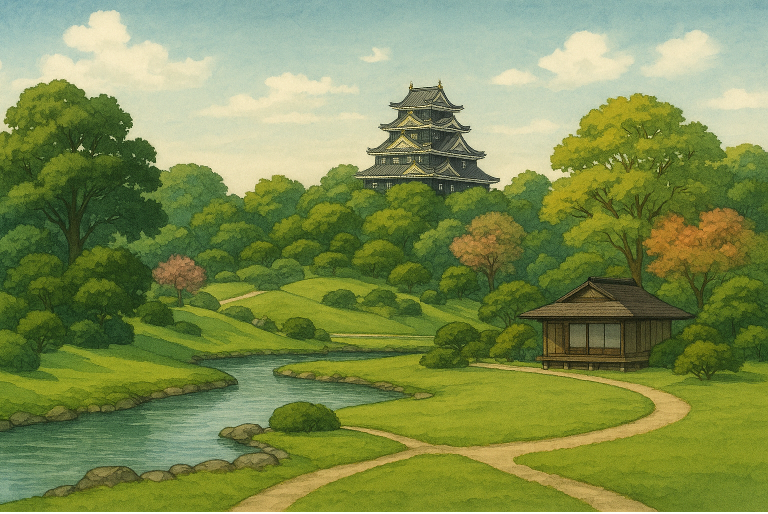
Korakuen, located in Okayama City, Okayama Prefecture, completes the trio of Japan’s “Three Great Gardens,” along with Kenrokuen in Kanazawa and Kairakuen in Mito. Renowned for its spacious lawns, flowing streams, and borrowed views of the majestic Okayama Castle, Korakuen is considered one of the finest examples of a daimyo (feudal lord) garden from the Edo period.
The garden was commissioned in 1687 by Ikeda Tsunamasa, the lord of Okayama, and completed in 1700. Unlike many enclosed Japanese gardens, Korakuen was designed with open spaces, giving it a uniquely expansive and airy atmosphere. Wide lawns stretch across the grounds, intersected by winding paths, tea houses, ponds, and groves of plum, cherry, and maple trees that transform beautifully with each season.
For visitors, Korakuen offers a chance to experience both history and tranquility. Seasonal highlights include cherry blossoms in spring, lotus flowers in summer, colorful foliage in autumn, and the serene landscapes of winter. English guide maps and signage are available, and the garden often hosts cultural events such as tea ceremonies and Noh performances. After exploring, visitors can easily cross the bridge to Okayama Castle, known as “Crow Castle” for its striking black exterior, and enjoy local specialties like Okayama-style barazushi (scattered sushi).
Korakuen is more than just a landscape—it is a cultural jewel where art, history, and nature blend seamlessly, offering a timeless glimpse into Japan’s refined garden tradition.
後楽園:岡山の景観調和の庭
後楽園は、岡山県岡山市にあり、金沢の兼六園、水戸の偕楽園と並ぶ、日本の「三名園」の最後を飾ります。広々とした芝生、流れる小川、そして雄大な岡山城の借景で知られ、後楽園は江戸時代の大名庭園の最高傑作のひとつとされています。
この庭園は1687年に岡山藩主・池田綱政によって命じられ、1700年に完成しました。多くの囲まれた日本庭園とは異なり、後楽園は開放的な空間を意図して設計されており、独特の広々とした、風通しの良い雰囲気を持っています。広い芝生が庭園全体に広がり、曲がりくねった小道、茶屋、池、梅や桜、紅葉の林が点在し、四季折々に美しく姿を変えます。
訪問者にとって、後楽園は歴史と静けさの両方を体験できる場所です。春の桜、夏のハスの花、秋の紅葉、冬の静謐な景観と、季節ごとの見どころがあります。英語のガイドマップや案内板も整備されており、庭園では茶会や能の公演といった文化行事が開催されることもあります。散策の後は、橋を渡って「烏城(うじょう)」の愛称で親しまれる黒い外観の岡山城を訪れたり、岡山名物のばらずしを味わうのもおすすめです。
後楽園は単なる景観ではありません。それは芸術、歴史、自然が完璧に溶け合う文化的宝石であり、日本の洗練された庭園文化を時を超えて垣間見ることができます。
